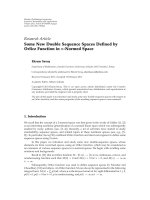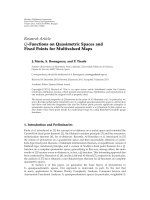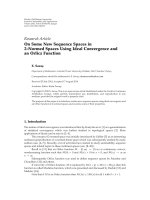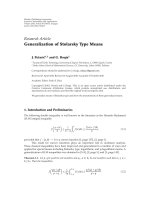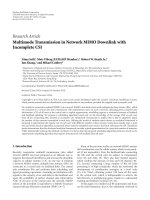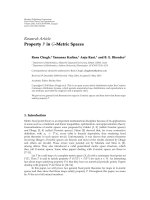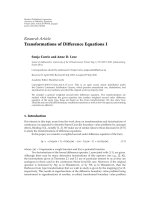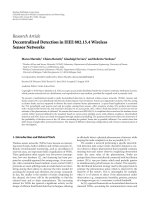báo cáo hóa học:" Research Article Property P in G-Metric Spaces" pot
Bạn đang xem bản rút gọn của tài liệu. Xem và tải ngay bản đầy đủ của tài liệu tại đây (490.92 KB, 12 trang )
Hindawi Publishing Corporation
Fixed Point Theory and Applications
Volume 2010, Article ID 401684, 12 pages
doi:10.1155/2010/401684
Research Article
Property P in G-Metric Spaces
Renu Chugh,
1
Tamanna Kadian,
1
Anju Rani,
1
and B. E. Rhoades
2
1
Department of Mathematics, Maharshi Dayanand University, Rohtak 124001, India
2
Department of Mathematics, Indiana University, Bloomington, IN 47405-7106, USA
Correspondence should be addressed to Renu Chugh,
Received 19 December 2009; Revised 1 May 2010; Accepted 13 May 2010
Academic Editor: Brailey Sims
Copyright q 2010 Renu Chugh et al. This is an open access article distributed under the Creative
Commons Attribution License, which permits unrestricted use, distribution, and reproduction in
any medium, provided the original work is properly cited.
We prove two general fixed theorems for maps in G-metric spaces and then show that these maps
satisfy property P .
1. Introduction
Metric fixed point theory is an important mathematical discipline because of its applications
in areas such as variational and linear inequalities, optimization, and approximation theory.
Generalizations of metric spaces were proposed by Gahler 1, 2called 2-metric spaces
and Dhage 3, 4called D-metric spaces.Hsiao5 showed that, for every contractive
definition, with x
n
: T
n
x
0
, every orbit is linearly dependent, thus rendering fixed
point theorems in such spaces trivial. Unfortunately, it was shown that certain theorems
involving Dhage’s D-metric spaces are flawed, and most of the results claimed by Dhage
and others are invalid. These errors were pointed out by Mustafa and Sims in 6,
among others. They also introduced a valid generalized metric space structure, which
they call G-metric spaces. Some other papers dealing with G-metric spaces are those in
7–11.
Let T be a self-map of a complete metric space X, d with a nonempty fixed point set
FT. Then T is said to satisfy property P if FTFT
n
for each n ∈ N. An interesting
fact about maps satisfying property P is that they have no nontrivial periodic points. Papers
dealing with property P are those in 12–14.
In this paper, we will prove two general fixed point theorems for maps in G-metric
spaces and then show that these maps satisfy property P. T hroughout this paper, we mean
by N the set of all natural numbers.
2 Fixed Point Theory and Applications
Definition 1.1 see 8.LetX be a nonempty set, and let G : X × X × X → R
be a function
satisfying the following axioms:
G1 Gx, y, z0ifx y z,
G2 0 <Gx, x, y for all x, y ∈ X with x
/
y,
G3 Gx, x, y ≤ Gx, y, z, for all x, y, z ∈ X,withz
/
y,
G4 Gx, y, zGx, z, yGy,z, x··· symmetry in all three variables,
G5 Gx, y, z ≤ Gx, a, aGa, y, z, for all x, y, z, a ∈ X rectangle inequality.
Then the function
G is called a generalized metric, or, more specifically, a G-metric on X,and
the pair X, G is called a G-metric space.
Definition 1.2 see 8.LetX, G and X
,G
be G-metric spaces and let f : X, G →
X
,G
be a function, then f is said to be G-continuous at a point a ∈ X;ifgivenε>0,
there exists δ>0 such that x,y ∈ X; Ga, x, y <δimplies that G
fa,fx,fy <ε.A
function f is G-continuous on X if and only if it is G-continuous at all a ∈ X.
Proposition 1.3 see 8. Let X, G, X
,G
be G-metric spaces, then a function f : X → X
is
G-continuous at a point x ∈ X if and only if it is G-sequentially continuous at x; that is, whenever
{x
n
} is G-convergent to x, {fx
n
} is G-convergent to fx.
Definition 1.4 see 8.LetX, G be a G-metric space, and let {x
n
} be a sequence of points
of X; therefore, we say that {x
n
} is G-convergent to x if lim
n,m →∞
Gx, x
n
,x
m
0; that is, for
any ε>0, there exists N ∈ N such that Gx, x
n
,x
m
<ε, for all n, m ≥ N. We call x the limit
of the sequence and write x
n
→ x or lim x
n
x.
Proposition 1.5 see 8. Let X, G be a G-metric space. Then the following are equivalent:
1 {x
n
} is G-convergent to x,
2 Gx
n
,x
n
,x → 0,asn →∞,
3 Gx
n
,x,x → 0,asn →∞,
4 Gx
m
,x
n
,x → 0,asm, n →∞.
Definition 1.6 see 8.LetX, G be a G-metric space. A sequence {x
n
} is called G-Cauchy
if, for each ε>0, there is N ∈ N such that Gx
n
,x
m
,x
l
<ε, for all n, m, l ≥ N;thatis,
Gx
n
,x
m
,x
l
→ 0asn, m, l →∞.
Proposition 1.7 see 8. In a G-metric space X, G the following are equivalent
1 The sequence {x
n
} is G-Cauchy.
2 For every ε>0,thereexistsN ∈ N such that Gx
n
,x
m
,x
m
<ε, for all
n, m ≥ N.
Proposition 1.8 see 8. Let X, G be a G-metric space. Then the function Gx, y, z is jointly
continuous in all three of its variables.
Definition 1.9 see 8.AG-metric space X, G is called a symmetric G-metric space if
G
x, y, y
G
y, x,x
∀x, y ∈ X. 1.1
Fixed Point Theory and Applications 3
Proposition 1.10 see 8. Every G-metric space X, G defines a metric space X, d
G
by
d
G
x, y
G
x, y, y
G
y, x,x
∀x, y ∈ X. 1.2
Note that, if X, G is a symmetric G-metric space, then
d
G
x, y
2G
x, y, y
, ∀x, y ∈ X. 1.3
However, if X, G is not symmetric, then it holds by the G-metric properties that
3
2
G
x, y, y
≤ d
G
x, y
≤ 3G
x, y, y
, ∀x, y ∈ X. 1.4
In general, these inequalities cannot be improved.
Proposition 1.11 see 8. A G-metric space X, G is G-complete if and only if X, d
G
is a
complete metric space.
Proposition 1.12 see 8. Let X, G be a G-metric space. Then, for any x, y, z, a ∈ X, it follows
that
1 if Gx, y, z0,thenx y z,
2 Gx, y, z ≤ Gx, x, yGx, x, z,
3 Gx, y, y ≤ 2Gy, x, x,
4 Gx, y, z ≤ Gx, a, zGa, y, z,
5 Gx, y, z ≤ 2/3{G
x, a, aGy, a, aGz, a, a}.
Theorem 1.13 see 15. Let T be a self-map of a metric space X such that X is T-orbitally complete.
Suppose that T satisfies
d
Tx,Ty
≤ k max
d
x, y
,d
x, Tx
,d
y, Ty
,d
x, Ty
,d
y, Tx
, 1.5
where k is a real number satisfying 0 ≤ k<1.ThenT has a unique fixed point u ∈ X. Moreover, for
each x ∈ X, lim T
n
x u and
d
T
n
x, u
≤
q
n
1 − q
d
x, Tx
. 1.6
4 Fixed Point Theory and Applications
2. Fixed Point Theorems
Theorem 2.1. Let X, G be a complete G-metric space, and let T be a self-mapof X satisfying, for all
x, y, z ∈ X,
G
Tx,Ty,Tz
≤ k max
G
x, y, z
,G
x, Tx, Tx
,G
y, Ty,Ty
,G
z, Tz, Tz
,
G
x, Ty, Ty
G
z, Tx, Tx
2
,
G
x, Ty, Ty
G
y, Tx,Tx
2
,
G
y, Tz, Tz
G
z, Ty, Ty
2
,
G
x, Tz, Tz
G
z, Tx, Tx
2
,
2.1
where k is a constant satisfying 0 ≤ k<1.ThenT has a unique fixed point (say p) and T is G-
continuous at p.
Proof. Let x
0
∈ X and define the sequence {x
n
} by x
n
T
n
x
0
. We may assume that x
n
/
x
n1
for each n ∈ N ∪{0}. For, if there exists an N such that x
N
x
N1
, then x
N
is a fixed point of
T.
From 2.1,withx x
n−1
, y z x
n
,
G
x
n
,x
n1
,x
n1
≤ k max
G
x
n−1
,x
n
,x
n
,G
x
n−1
,x
n
,x
n
,G
x
n
,x
n1
,x
n1
,
G
x
n
,x
n1
,x
n1
,
G
x
n−1
,x
n1
,x
n1
0
2
,
G
x
n−1
,x
n1
,x
n1
0
2
,
G
x
n
,x
n1
,x
n1
,
G
x
n−1
,x
n1
,x
n1
0
2
,
2.2
Gx
n
,x
n1
,x
n1
≤ kM
n
,say.
Suppose that, for some n ∈ N, M
n
Gx
n
,x
n1
,x
n1
. Then we have
G
x
n
,x
n1
,x
n1
≤ kG
x
n
,x
n1
,x
n1
, 2.3
which is a contradiction, since x
n
’s are distinct.
Suppose that there is an n ∈ N for which M
n
Gx
n−1
,x
n1
,x
n1
/2. Using property
G5,
G
x
n−1
,x
n1
,x
n1
≤ G
x
n−1
,x
n
,x
n
G
x
n
,x
n1
,x
n1
, 2.4
and one obtains
G
x
n
,x
n1
,x
n1
≤
k
2
{
G
x
n−1
,x
n
,x
n
G
x
n
,x
n1
,x
n1
}
, 2.5
Fixed Point Theory and Applications 5
which leads to
G
x
n
,x
n1
,x
n1
≤
k
2 − k
G
x
n−1
,x
n
,x
n
<kG
x
n−1
,x
n
,x
n
, since k<1. 2.6
Thus, we get
G
x
n
,x
n1
,x
n1
≤ kG
x
n−1
,x
n
,x
n
≤···≤k
n
G
x
0
,x
1
,x
1
. 2.7
For every m, n ∈ N,m>n,usingG5,
G
x
n
,x
m
,x
m
≤ G
x
n
,x
n1
,x
n1
··· G
x
m−1
,x
m
,x
m
≤
k
n
··· k
m−1
G
x
0
,x
1
,x
1
≤
k
n
1 − k
G
x
0
,x
1
,x
1
.
2.8
Therefore {x
n
} is G-Cauchy, hence G-convergent, since X is G-complete. Call the limit p.
From 2.1 with x x
n
, y z p,
G
x
n1
,Tp,Tp
≤ k max
G
x
n
,p,p
,G
x
n
,x
n1
,x
n1
,G
p, Tp, Tp
,G
p, Tp, Tp
,
G
x
n
,Tp,Tp
G
p, x
n1
,x
n1
2
,
G
x
n
,Tp,Tp
G
p, x
n1
,x
n1
2
,
G
p, Tp, Tp
,
G
x
n
,Tp,Tp
G
p, x
n1
,x
n1
2
.
2.9
Taking the limit of both sides of 2.9 as n →∞yields
G
p, Tp, Tp
≤ kG
p, Tp, Tp
, 2.10
which implies that Gp, Tp, Tp0 and hence p Tp.
Suppose that q is also a fixed point of T. Then, from 2.1 with x p, y z q,
G
p, q, q
≤ k max
G
p, q, q
, 0, 0, 0,
G
p, q, q
G
q, p, p
2
,
G
p, q, q
G
q, p, p
2
, 0,
G
p, q, q
G
q, p, p
2
,
2.11
which implies that
G
p, q, q
≤
k
2 − k
G
q, p, p
. 2.12
6 Fixed Point Theory and Applications
Using 2.1 again, this time with x q, y z p,oneobtains
G
q, p, p
≤ k max
G
q, p, p
, 0, 0, 0,
G
q, p, p
G
p, q, q
2
,
G
q, p, p
G
p, q, q
2
, 0,
G
q, p, p
G
p, q, q
2
,
2.13
which implies that
G
q, p, p
≤
k
2 − k
G
p, q, q
. 2.14
Combining 2.12 and 2.14 gives
G
p, q, q
≤
k
2 − k
2
G
p, q, q
. 2.15
Therefore, p q,sincek/2 − k < 1.
Let {y
n
}⊂X be any sequence with limit p.Using2.1 with x z y
n
,y p,
G
Ty
n
,Tp,Ty
n
≤ k max
G
y
n
,p,y
n
,G
y
n
,Ty
n
,Ty
n
, 0,G
y
n
,Ty
n
,Ty
n
,
G
y
n
,p,p
G
y
n
,Ty
n
,Ty
n
2
,
G
y
n
,p,p
G
p, Ty
n
,Ty
n
2
,
2.16
That is,
G
Ty
n
,p,Ty
n
≤ k max
G
y
n
,p,y
n
,G
y
n
,Ty
n
,Ty
n
,
G
y
n
,p,p
G
y
n
,Ty
n
,Ty
n
2
,
G
y
n
,p,p
G
p, Ty
n
,Ty
n
2
.
2.17
Using the fact that, from G5,
G
y
n
,Ty
n
,Ty
n
≤ G
y
n
,p,p
G
p, Ty
n
,Ty
n
,
G
Ty
n
,p,Ty
n
≤ kL, say.
2.18
Fixed Point Theory and Applications 7
If, for some n, L is equal to Gy
n
,p,y
n
, then we have
G
Ty
n
,p,Ty
n
≤ kG
y
n
,p,y
n
. 2.19
If, for some n, L is equal to Gy
n
,Ty
n
,Ty
n
, then, using G5,
G
Ty
n
,p,Ty
n
≤ kG
y
n
,Ty
n
,Ty
n
≤ G
y
n
,p,p
G
p, Ty
n
,Ty
n
, 2.20
which implies that
G
Ty
n
,p,Ty
n
≤
k
1 − k
G
y
n
,p,p
. 2.21
If, for some n, L is equal to Gy
n
,p,pGy
n
,Ty
n
,Ty
n
/2, then, using G5,
G
Ty
n
,p,Ty
n
≤
k
2
G
y
n
,p,p
G
y
n
,p,p
G
p, Ty
n
,Ty
n
, 2.22
which implies that
G
Ty
n
,p,Ty
n
≤
2k
2 − k
G
y
n
,p,p
. 2.23
If, for some n, L is equal to Gy
n
,p,pGp, Ty
n
,Ty
n
/2, then, using G5,
G
Ty
n
,p,Ty
n
≤
k
2
G
y
n
,p,p
G
p, Ty
n
,Ty
n
, 2.24
which implies that
G
Ty
n
,p,Ty
n
≤
k
2 − k
G
y
n
,p,p
. 2.25
Therefore, for all n, lim Gp, Ty
n
,Ty
n
0andT is G-continuous at p.
Special cases of Theorem 2.1 are Theorem 2.1of9 and Theorems 2.1, 2.4, 2.6, and 2.8
of 10.
Theorem 2.2. Let X, G be a complete G-metric space, and let T be a self-map of X satisfying, for all
x, y, z ∈ X,
G
Tx,Ty,Tz
≤ k max
G
x, y, z
,G
x, Tx, Tx
,G
y, Ty,Ty
,
G
x, Ty, Ty
,G
y, Tx,Tx
,G
z, Tz, Tz
,
2.26
8 Fixed Point Theory and Applications
or
G
Tx,Ty,Tz
≤ k max
G
x, y, z
,G
x, x, Tx
,G
y, y, Ty
,
G
x, x, Ty
,G
y, y, Tx
,G
z, z, Tx
,
2.27
where k is a constant satisfying 0 ≤ k<1.ThenT has a unique fixed point (call it p) and T is
G-continuous at p.
Proof. Suppose that T satisfies 2.26.Using2.26 with z y, we have
G
Tx,Ty,Ty
≤ k max
G
x, y, y
,G
x, Tx, Tx
,G
y, Ty,Ty
,G
x, Ty, Ty
,G
y, Tx,Tx
.
2.28
Suppose that X, G is symmetric.
From Proposition 1.10 , d
G
, defined by d
G
x, y2Gx, y, y makes, X, d
G
into a
metric space. Substituting into 2.28 and then multiplying by 2 yield
d
G
Tx,Ty
≤ k max
d
G
x, y
,d
G
x, Tx
,d
G
y, Ty
,d
G
x, Ty
,d
G
y, Tx
. 2.29
From Theorem 1.13, T has a unique fixed point.
Suppose that X, G is not symmetric. Define
A
n
G
T
i
x, T
j
x, T
j
x
:0≤ i, j ≤ n
,
δ
n
max
i,j
A
n
.
2.30
Then δ
n
GT
i
x, T
m
x, T
m
x for some i, m satisfying 0 ≤ i, m ≤ n.
Suppose that i>0. Then, from 2.26,
δ
n
G
x
i
,x
m
,x
m
≤ k max
{
G
x
i−1
,x
m−1
,x
m−1
,G
x
i−1
,x
i
,x
i
,G
x
m−1
,x
m
,x
m
,G
x
i−1
,x
m
,x
m
,G
x
m−1
,x
i
,x
i
}
≤ kδ
n
,
2.31
a contradiction. Therefore, i 0.
Thus, for some m satisfying 0 ≤ m ≤ n, using property G5 and 2.26,
δ
n
G
x
0
,x
m
,x
m
≤ G
x
0
,x
1
,x
1
G
x
1
,x
m
,x
m
≤ G
x
0
,x
1
,x
1
k max
{
G
x
0
,x
m−1
,x
m−1
,G
x
0
,x
1
,x
1
,
G
x
m−1
,x
m
,x
m
,G
x
0
,x
m
,x
m
,G
x
m−1
,x
1
,x
1
}
≤ G
x
0
,x
1
,x
1
kδ
n
,
2.32
Fixed Point Theory and Applications 9
which implies that
δ
n
≤
1
1 − k
G
x
0
,x
1
,x
1
, 2.33
and δ
n
is bounded in n. Call this bound δ.
Define x
n
Tx
n−1
. Without loss of generality, we may assume that x
n
/
x
n1
for each n.
For, if there exists an N for which x
N
x
N1
, then x
N1
Tx
N
and x
N
is a fixed point of T.
Again from 2.26 ,
G
x
n
,x
n1
,x
n1
≤ k max
{
G
x
n−1
,x
n
,x
n
,G
x
n−1
,x
n
,x
n
,G
x
n
,x
n1
,x
n1
,G
x
n−1
,x
n1
,x
n1
, 0
}
k max
{
G
x
n−1
,x
n
,x
n
,G
x
n−1
,x
n1
,x
n1
}
≤ k max
{
G
x
n−1
,x
n
,x
n
,δ
}
≤···≤k
n
max
{
G
x
0
,x
1
,x
1
,δ
}
≤ k
n
δ.
2.34
For any m, n ∈ N; m>n,
G
x
n
,x
m
,x
m
≤ G
x
n
,x
n1
,x
n1
G
x
n1
,x
n2
,x
n2
··· G
x
m−1
,x
m
,x
m
≤
k
n
k
n1
··· k
m−1
δ ≤
k
n
δ
1 − k
.
2.35
Therefore, lim Gx
n
,x
m
,x
m
0asm, n →∞and {x
n
} is G-Cauchy, hence G-convergent,
since X is G-complete. Call the limit p.
From 2.26,
G
x
n
,Tp,Tp
≤ k max
G
x
n−1
,p,p
,G
x
n
,x
n1
,x
n1
,G
p, Tp, Tp
,
G
x
n−1
,Tp,Tp
,G
p, x
n
,x
n
.
2.36
Taking the limit of both sides of 2.36 as n →∞yields
G
p, Tp, Tp
≤ kG
p, Tp, Tp
, 2.37
which implies that p Tp.
Suppose that q is another fixed point of T with p
/
q. Then, from 2.26,
G
p, q, q
≤ k max
G
p, q, q
, 0, 0,G
p, q, q
,G
q, p, p
kG
q, p, p
. 2.38
10 Fixed Point Theory and Applications
Again using 2.26,
G
q, p, p
≤ k max
G
q, p, p
, 0, 0,G
q, p, p
,G
p, q, q
kG
p, q, q
. 2.39
Combining 2.36 and 2.38 gives Gp, q, q ≤ k
2
Gp, q, q, a contradiction. Therefore p q
and the fixed point is unique.
Now let {y
n
}⊂X with lim y
n
p.Using2.26,
G
Ty
n
,p,Ty
n
≤ k max
G
y
n
,p,y
n
,G
y
n
,Ty
n
,Ty
n
, 0,G
y
n
,p,p
,
G
p, Ty
n
,Ty
n
,G
y
n
,Ty
n
,Ty
n
2.40
But from G5, we have
G
y
n
,Ty
n
,Ty
n
≤ G
y
n
,p,p
G
p, Ty
n
,Ty
n
. 2.41
Therefore, 2.40 reduces to
G
Ty
n
,p,Ty
n
≤ max
kG
y
n
,p,y
n
,
k
1 − k
G
y
n
,p,p
. 2.42
Taking the limit of both sides of the above equation as n →∞gives lim GTy
n
,p,Ty
n
0,
which implies that lim Ty
n
p,andT is G-continuous at p.
The proof using 2.27 is similar. Special cases of Theorem 2.2 are Theorems 2.5, 2.8,
and 2.9 of 9.
3. Property P
In this section we shall show that maps satisfying 2.1 or 2.26 possess property P .
Theorem 3.1. Under the conditions of Theorem 2.1, T has property P .
Proof. From Theorem 2.1, T has a fixed point. Therefore FT
n
/
∅ for each n ∈ N.Fixn>1
and assume that p ∈ FT
n
.Wewishtoshowthatp ∈ FT.
Fixed Point Theory and Applications 11
Suppose that p
/
Tp.Using2.1,
G
p, Tp, Tp
G
T
n
p, T
n1
p, T
n1
p
≤ k max
G
T
n−1
p, T
n
p, T
n
p
,G
T
n−1
p, T
n
p, T
n
p
,G
T
n
p, T
n1
p, T
n1
p
,
G
T
n
p, T
n1
p, T
n1
p
,
G
T
n−1
p, T
n1
p, T
n1
p
0
2
,
G
T
n−1
p, T
n1
p, T
n1
p
0
2
,
G
T
n
p, T
n1
p, T
n1
p
G
T
n
p, T
n1
p, T
n1
p
2
,
G
T
n−1
p, T
n1
p, T
n1
p
0
2
kG
T
n−1
p, T
n
p, T
n
p
≤ k
2
G
T
n−2
p, T
n−1
p, T
n−1
p
≤···≤k
n
G
p, Tp, Tp
,
3.1
a contradiction.
Therefore p ∈ FT and T has property P.
Theorem 3.2. Under the conditions of Theorem 2.2, T has property P .
Proof. From Theorem 2.2, T has a fixed point. Therefore FT
n
/
∅for each n ∈ N.Fixn>1
and assume that p ∈ FT
n
.Using2.26 and assuming that p
/
Tp, we have
G
p, Tp, Tp
G
T
n
p, T
n1
p, T
n1
p
≤ k max
G
T
n−1
p, T
n
p, T
n
p
,G
T
n−1
p, T
n
p, T
n
p
,
G
T
n
p, T
n1
p, T
n1
p
,G
T
n−1
p, T
n1
p, T
n1
p
, 0, 0
.
3.2
Define B
n
{GT
i
p, T
j
p, T
j
p :0≤ i, j ≤ n}. Then
δ
n
max
i,j
B
n
. 3.3
Then, δ
n
GT
i
p, T
m
p, T
m
p for some 0 ≤ i, m ≤ n.
12 Fixed Point Theory and Applications
Assume that δ
n
> 0. Then from 2.26,
δ
n
G
T
i
p, T
m
p, T
m
p
≤ k max
G
T
i−1
p, T
m−1
p, T
m−1
p
,G
T
i−1
p, T
i
p, T
i
p
,G
T
m−1
p, T
m
p, T
m
p
,
G
T
i−1
p, T
m
p, T
m
p
,G
T
m−1
p, T
i
p, T
i
p
,G
T
m−1
p, T
m
p, T
m
p
≤ kδ
n
,
3.4
a contradiction. Therefore δ
n
0. In particular, Gp, Tp, Tp0andp Tp.
Acknowledgment
The authors would like to thank the Editor-in-Chief and referees for the valuable suggestions
and corrections for the improvement of this paper.
References
1 S. Gahler, “2-metrische R
¨
aume und ihre topologische Struktur,” Mathematische Nachrichten, vol. 26,
pp. 115–148, 1963.
2 S. Gahler, “Zur geometric 2-metriche raume,” Revue Roumaine de Math
´
ematiques Pures et Appliqu
´
ees,
vol. 40, pp. 664–669, 1966.
3 B. C. Dhage, “Generalized metric space and mapping with fixed point,” Bulletin of the Calcutta
Mathematical Society, vol. 84, pp. 329–336, 1992.
4 B. C. Dhage, “Generalized metric spaces and topological structure. I,” Analele S¸tiint¸ifice ale Universit
˘
atii
“Al. I. Cuza” din Ias¸i. Serie Nou
˘
a. Matematic
˘
a , vol. 46, no. 1, pp. 3–24, 2000.
5 C. R. Hsiao, “A property of contractive type mappings in 2-metric spaces,” J
˜
n
¯
an
¯
abha, vol. 16, pp. 223–
239, 1986.
6 Z. Mustafa and B. Sims, “Some remarks concerning D-metric spaces,” in Proceedings of the International
Conference on Fixed Point Theory and Applications, pp. 189–198, Valencia, Spain, 2003.
7 Z. Mustafa, A new structure for generalized metric spaces—with applications to fixed point theory, Ph.D.
thesis, The University of Newcastle, Callaghan, Australia, 2005.
8 Z. Mustafa and B. Sims, “A new approach to generalized metric spaces,” Journal of Nonlinear and
Convex Analysis, vol. 7, no. 2, pp. 289–297, 2006.
9 Z. Mustafa, H. Obiedat, and F. Awawdeh, “Some fixed point theorem for mapping on complete G-
metric spaces,” Fixed Point Theory and Applications, vol. 2008, Article ID 189870, 12 pages, 2008.
10 Z. Mustafa and B. Sims, “Fixed point theorems for contractive mappings in complete G-metric
spaces,” Fixed Point Theory and Applications, vol. 2009, Article ID 917175, 10 pages, 2009.
11 M. Abbas and B. E. Rhoades, “Common fixed point results for noncommuting mappings without
continuity in generalized metric spaces,” Applied Mathematics and Computation, vol. 215, no. 1, pp.
262–269, 2009.
12 G. S. Jeong and B. E. Rhoades, “Maps for which FTFT
n
,” in Fixed Point Theory and Applications.
Vol. 6, pp. 71–105, Nova Sci. Publ., New York, NY, USA, 2007.
13 G. S. Jeong and B. E. Rhoades, “More maps for which FTFT
n
,” Demonstratio Mathematica, vol.
40, no. 3, pp. 671–680, 2007.
14 B. E. Rhoades and M. Abbas, “Maps satisfying generalized contractive conditions of integral type for
which FTFT
n
,” International Journal of Pure and Applied Mathematics, vol. 45, no. 2, pp. 225–231,
2008.
15 Lj. B.
´
Ciri
´
c, “A generalization of Banach’s contraction principle,” Proceedings of the American
Mathematical Society, vol. 45, pp. 267–273, 1974.
